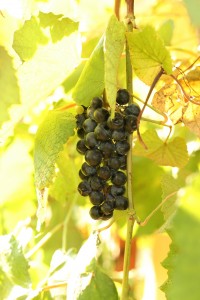Norton: Dark Knight of American Wine
This is the first article of a two part profile on the Norton grape. The first article discusses the characteristics of today’s Norton and includes a report on the 2012 Norton Harvest. The next article will focus on Norton winemaking techniques and research into the origins of the grape.
Norton, the oldest commercially grown native American grape, is a red variety with a unique flavor, a dramatic history and a cult-like following. The grape produces some of the best dry red wines in the Midwest. However, even in Missouri, where Norton is the state grape, many locals have never heard of it. Despite being an unsung hero, the number of wineries producing quality Nortons has grown in recent years and the grape continues to inspire wine enthusiasts like no other native variety.
Norton is grown commercially in more than 20 states, from as far south as Florida to Pennsylvania in the north. Missouri has the largest acreage of Norton with more than 300, but Chrysalis Vineyards in Virginia claims to have the largest single planting of Norton vines with about 40 acres.
The grape is called Cynthiana in Arkansas. Although some wine enthusiasts say the two grapes are different, studies have shown that Norton and Cynthiana are genetically identical. The flavor profile of this deep purple colored wine includes acid, spice, dark fruit and pomegranates. Other native American grapes can produce sweet or ‘foxy’ flavors, but Norton is very dry, full-bodied and generally improves with aging.
Kansas City based wine expert Doug Frost describes Norton as “powerful, muscular, crazy intense in malic acid and capable of staining teeth or even wineglasses.” Rather than fruit forward and powerful in a New World style of a big Californian Cabernet or an Australian Syrah, Norton lacks their tannic structure and can be like a muscular version of the more classic European red wine styles.
Dave Johnson, from Stone Hill Winery in Missouri and a maker of Norton for more than three decades, compares some Norton flavor characteristics to Italy’s Barbera grape. His winemaking colleague at Stone Hill, Shaun Turnbull, includes spice, clove, cinnamon, leather and truffle notes in the flavor profile of a good Norton. Young Norton’s can be acidic and tart, a characteristic seen by some as a trademark of this wine. Tim Puchta, another veteran Norton winemaker from Adam Puchta Vineyards in Missouri, proudly calls himself a Norton “acid geek.”
“…powerful, muscular, crazy intense in malic acid”
Doug Frost, Kansas City based wine expert describing Norton
Norton is the most expensive non-vinifera, or non-European, wine available to Midwest consumers and usually costs about $20 a bottle. Norton enthusiast Paul Roberts, winemaker at Deep Creek Cellars in Maryland, says prices have as much as quadrupled in recent years and attributes the increase to growing demand. Demand has been driven by a jump in the quality of Norton wines, partly due to winemakers sharing knowledge through universities and state sponsored groups like the Missouri Wine Technical Group.
See related story: Inside Look at Missouri Wine Technical Group
The relative expense of a bottle of Norton is also a result of the extra time and money required to produce a quality Norton. Even in its Midwest heartland, the Norton is still a niche market and easily outsold by dry red wines from California and France and by locally made sweet wines. At Belvoir Winery in Liberty, Missouri, which sells a selection of six wines, dry to sweet, all made from local grapes, the Norton makes up about 10% of wine sales.
Norton grapes are small in size compared to other varietals and are often harvested later in the season. However, the ripening powers of this summer’s long drought mean that many Norton growers are harvesting their grapes about two weeks early.
At Westphalia Vineyards in the south-east corner of Missouri, winemaker Terry Neuner and his family have just finished harvesting their four acres of Norton. Terry Neuner says after a year of severe frosts and drought, their Norton crop is ‘way better than we ever expected.” Neuner was anticipating half the volume of last year’s crop yield but says it’s very likely they’ll have more, or about 20 tons of grapes.
At Jowler Creek Vineyard near Kansas City, winemaker Colleen Gerke is also optimistic. Their two acres of Norton vines – the oldest are eight years old and the youngest two years – are irrigated so the drought wasn’t an issue. Earlier in the year they protected their grapes from frost damage by spraying them with water and nutrients in the middle of the night. Based on this year’s growing season, Gerke says she expects ‘epic” fruit when they harvest their Norton during the middle of September. ‘All and all, this should be some of the highest quality fruit ever from our vineyard,” she says.
[wp_geo_map]





It’s a busy time right now, but be sure to get your hands on a copy of The Wild Vine:A Forgotten Grape and the Untold Story of American Wine, by Todd Kliman. Loved it. Highly recommended read. Focus is on Norton, but the history of American wine-making, the personalities, and political history is fascinating.
http://www.amazon.com/The-Wild-Vine-Forgotten-American/dp/0307409376/ref=tmm_pap_title_0
Yes that’s a great book Susan! Stay tuned for part 2 of this Norton article where that book is discussed a little, plus other literary works inspired by Norton. You can see a video interview with Todd Kliman here: http://midwestwinepress.com/?s=Todd+Kliman
all the best
Danny Wood
Has Norton been around longer that Catawba which made it’s apperance in 1823?
Hi Jim,
Thanks for your comment…I believe it is very hard to be precise about the exact date of Norton’s discovery by Daniel Norton, but usually the date is referred to as the 1820s, sometimes 1820, sometimes 1823 and sometimes 1830 ! So it could be a tie!
best
Danny Wood
I don’t think it is not correct to say that Norton is plagued with high malic but instead with high postassium levels. A seasoned winemaker can easily get rid of malic with a secondary fermentation but it is the postassium that is the achilles heel?
Hi Michael,
Thanks for taking the time to comment…can any Norton winemakers clarify the potassium issue that Michael has raised?
Danny Wood
took this off a posting that i put on wine press.us a year or so ago. was easier to cut and paste versus retyping it
The way I understand the potassium
Norton grape roots do well in taking potassium out of the soil. This is the key reason potassium is not added during fertilization of the vines, Just Nitrogen for the most part. The potassium taken in by the roots is stored in the fruit. The effect of the potassium on the wine is an increased ph. The Norton wine will have a high ph and high acid content. To reduce the ph you need to lower the potassium and the way to do that is to add tartaric acid to the wine until the ph is at 3.55 when Tartaric acid is added to a ph below 3.45 a buffering action takes place or “buffering capacity” and is better explained on page 535 of “principles of wine making” – a book that is available to read online- you can google it.
anyway, if tartaric acid is added below 3.55 the potassium ions will attach to the tartaric acid which can be dropped out of the solution by doing a cold stabilization at 28 degrees for 2 weeks. If you add tartaric acid to the wine but do not get down to the 3.55 range the potassium ions will never attach to the tartaric acid as you have yet to reach the buffering zone of the solution. I am not a chemist but I feel that it does not matter if you do this early on or if you wait right before bottling. Either way the potassium will be reduced early on or later with the addition of Tartaric acid. However, most chose to do this early on so the wine has time to integrate with the oak and tannins
read this with regard to Norton ….
http://www.uark.edu/depts/ifse/grapeprog/articles/ahis05wg.pdf
…thanks very much Jim for both your comments and the detail on the potassium factor and how to reduce it. If anyone else would like to venture a comment on their experience making Norton wine and how difficult this process of removing the potassium is and whether it might be Norton’s Achilles heel, please do…
all the best
Danny
I have been fortunate enough to be vinifying Norton for the past 7 years with (in my opinion) one of the most modern pioneers and unsung heroes of the wine itself and this is what I can add.
I would say that high potassium levels and malic acid is the Bane and Ra`s al Ghul to Norton. The best way to try and control the high potassium levels is to really pay attention to shoot positioning. This will not completely solve the problem but make it a bit easier to manage in the winery. Different rootstocks have been trialled but with no real good success.
In the winery the malic acid combined with the high pH (related to high potassium) after crushing makes for a tricky situation. The most common way to reduce pH is to add tartaric acid. But being Norton with its already very high malic acid content, which gives a very sharp and unattractive mouth feel for a red wine, adding acid on top of the already high malic acid content is just going to alleviate this already improper organoleptic aspect. Obviously to have a healthy fermentation it is necessary to try and get the pH down to more manageable and safer level (below 3.60 pH). The lower pH will also help to stabilize and improve color. So reducing the pH during fermentation is necessary.
Post fermentation malolactic fermentation would indeed help reduce the malic acid but it would again raise the pH which will leave the wine more prone to spoilage and browning. Thus again pH management is needed. The most common way? To add some tartaric acid. Too much and the wine will be too acidic for a red wine.
Thus, it is a very delicate process getting the Norton palatable in regards to a balanced red wine acid profile having grapes with high potassium and malic acid content.
Thanks for your comment Shaun. It’s great to be reading all these insights into the complexities of Norton winemaking. For those readers who don’t know, I’m pretty certain the Norton pioneer you refer to is your colleague at Stone Hill Winery, Dave Johnson, who has been making Norton wine for more than three decades.
all the best
Danny
The acid balance of Norton is predicated on the canopy and cluster exposure to the sun. The reality is that Norton does have a high malate, however, if the grapes get adequate sun exposure then the numbers become much more in balance.